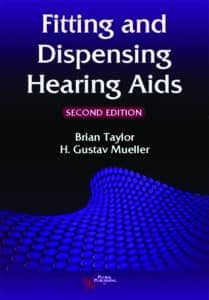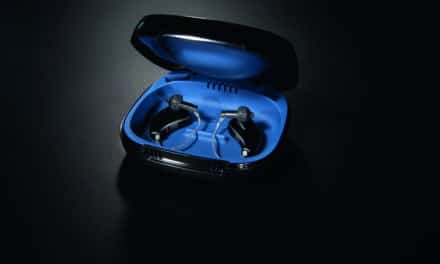Inside Clinical Research | December 2016 Hearing Review
Anyone who follows the hearing healthcare literature is certain to encounter and enjoy the work of Brian Taylor, AuD. Dr Taylor is an audiologist who wears many hats. He is the senior director of clinical affairs at Turtle Beach and the clinical audiology advisor for the Fuel Medical Group. He also serves as an adjunct professor at A.T. Still University Arizona School of Health Sciences, is the editor of the “Hearing News Watch” blog for HearingHealthMatters.org, as well as the treasurer for the Accreditation Commission for Audiology Education (ACAE). With nearly 25 years of clinical and practice management experience, including a variety of prominent positions within the hearing industry, Brian has now written four books about hearing healthcare, including a recent update for one of his most popular texts.
Beck: Hi Brian. Congratulations on the Second Edition of Fitting and Dispensing Hearing Aids from Plural Publishing, written collaboratively between you and my old pal (and one of the smartest guys in the world, with regard to hearing aids, anyway!), Gus Mueller, PhD. The book was a joy to read, and although you did revise and go over some new ground, I was wondering what inspires a busy guy like you to write a second edition?
Taylor: Hi Doug. Thanks for your interest in the book. Like the first edition of the book, which was published 5 years ago, we wanted to create a practical, straightforward source for all the essential things you need to know to fit your first set of hearing aids. The book is really meant for non-audiologists who are studying to obtain their hearing aid dispensing license. As it turned out, the first edition became a popular introductory text for first-year audiology students, too.
I attribute the book’s popularity to its cookbook-like approach. Like a good cookbook, it focuses more on how to conduct essential clinical tasks and less on the underlying theories. Not that the underlying theory is unimportant. It’s just that you can get that information in other places, like the book Gus wrote with Todd Ricketts and Ruth Bentler, Modern Hearing Aids, or Harvey Dillon’s Hearing Aids, or even the book nearly every audiologist has on their shelf, Jack Katz’s The Handbook of Clinical Audiology, to name just a few.
Beck: Fair enough. Brian, as you know, I’ve been standing on my soapbox and saying the first hundred years of audiology were about hearing, and the second hundred years (starting, more-or-less, now!) will be about listening. Since WWII, we’ve learned how to measure hearing, how to build consistent and accurate audiometric tools with calibration protocols, and how to describe hearing loss based on degree and configuration—all of which serves as the foundation for all that hearing healthcare professionals must know inside out. However, if all we’re doing is making things louder, that doesn’t require or use the special skill set hearing healthcare professionals possess.
Taylor: You bring up many thought-provoking points. First, good audiology will never go out of style. By that I mean it doesn’t matter whether you sit behind a 40-year-old audiometer spinning dials, or whether the test battery is completely automated; audiologists and hearing instrument specialists contribute to the process of identifying ear disease and making proper referrals before hearing aids are fitted. This requires, at a minimum, a cursory knowledge of ear anatomy, how to conduct a thorough case history, and the basics of the audiologic assessment. That’s why the first five chapters of our book don’t even mention hearing aids.

We updated Chapter 1 of our book to reflect the importance of listening to patients. We added some material on the Trans-theoretical Stages-of-Change model and motivational interviewing tips. Keeping with the spirit of the book, we provided just enough to get you started using these important concepts to help the patient become a better listener!
Since I’m talking about some of the new things we added to the second edition, let me mention we also updated the chapter on advanced hearing aid features. As most of your readers know, hearing aid features continue to evolve and a lot has changed since the first edition in 2011. We added some material on null steering directional microphones, frequency lowering, wireless accessories, and audio data transfer between hearing aids.
With changes in hearing aid technology, it follows that you have to refresh the way clinicians verify how these features work in the ear, so we also updated the chapter devoted to prescriptive fitting methods and the use of probe-microphone measures in the verification process. Again, we strived to provide just enough information to get you started using proper prescriptive fitting methods and verification techniques to fit any modern hearing aid.
Lastly, we updated Chapter 11, which is devoted to outcome measures. As you know, there are dozens of outcome measures. In fact, I think there are so many it is easy to become overwhelmed and not use any of them. Therefore, the new edition reviews the importance of validating your hearing fittings. We looked at just a handful of outcome measures. We even mention in the new edition that, if you choose one validation measure, make it the International Outcome Inventory for Hearing Aids (IOI-HA). You’ll have to read the book to learn why we focus on this one simple validation measure.
Beck: Agreed. There are many advantages to the IOI-HA, and it’s easy to use. Further, whenever I speak about verification and validation (V&V), I urge our colleagues—particularly the trainees and newly licensed professionals—to get a copy of the June 2011 Hearing Review article by Sergei Kochkin addressing how to reduce the number of visits involved in modern hearing aid dispensing simply by using best practices from the beginning, including V&V [see https://hearingreview.com/2011/06/marketrak-viii-reducing-patient-visits-through-verification-amp-validation]. The article was and remains cutting edge, it’s revealing, and very important. Kochkin states, “The utilization of verification and validation during the hearing aid fitting process was shown to significantly reduce patient visits (1.2 fewer visits), with evidence that utilizing both verification and validation may compound to yield the best results…” As he pointed out back in 2011—and it likely hasn’t changed in 2016—about 33% of all hearing healthcare practices report using V&V (my guess is it’s closer to 20%). Further he states “MarkeTrak VIII data suggest that wide-scale adoption of verification and validation in the US hearing care market will increase patient satisfaction and reduce patient visits…”
Taylor: Yes, hearing care professionals need to pay attention to Sergei’s findings. As I mentioned, our chapters on hearing aid fitting procedures and outcome assessments provide practical guidance on how to conduct these basic measures, including how (and why) to measure both patient benefit and patient satisfaction.
Beck: Another huge area for the hearing healthcare professional is appreciating and managing Speech-In-Noise (SIN). I often argue (back up on my soap box) the vast majority of the technical work we do—audiograms, reflexes, OAEs, tymps—is accomplished to find out who needs medical referrals for potential surgically or medically correctable problems. It can be argued that perhaps 95% of all people who self-refer for “hearing loss” are the ones having difficulty understanding speech in noise, and those technical tests done for medical purposes don’t reveal the extent of the SIN problem which is causing “pain” for the patient (ie, not being able to understand speech in noise).
That is, some people with mild high-frequency hearing loss have substantial difficulty secondary to their hearing loss, but for other people, the identical hearing loss causes only a tiny problem, on rare occasions. Importantly, there’s more in play here than what a simple audiogram can reveal. The brain’s ability to separate, organize, focus, and recognize the sounds they hear is the bigger factor! Further, those simple medically based tests are generally not predictive of, or even correlated with, an individual’s SIN score. That is, despite the traditional clinically based idea that one can peek at an audiogram to determine what the likely SIN might be, in reality, this cannot be guessed at; it must be tested.
Fortunately, testing it is easy, and should be done in the sound field. As you reported above, it’s a simple matter to test SIN unaided, and compare it to aided scores to see if we’ve helped the patient understand SIN. If we haven’t shown benefit here, there’s a reasonable chance that all we’ve done is make it louder. In that case, if the patient’s goal was to understand better in background noise, and all we’ve done is make sound louder, we need to consider that, from the patient’s perspective, we have failed. I suspect that’s why you offer so much information about SIN in the new book?
Taylor: Absolutely. Although we review several speech-in-noise tests, let me offer the readers a little information on perhaps the most practical one to use in the clinic: the QuickSIN. The QuickSIN was designed by Mead Killion, it is well-known and easy to use. The QuickSIN has 12 lists of sentences of equivalent difficulty, and 5 key words which are scored. We go into detail about this in the new book, as well as brief descriptions of the BKB-SIN, which uses simpler and shorter sentences.
Beck: And also in that section you describe the Hearing In Noise Test (HINT) and many other useful protocols for assessing and measuring what the actual real-world experience of the patient is, and of equal importance, the tools we can use to see if we’re solving the perceived problem (SIN), or have simply made the world louder!
Taylor: When it comes to selecting and fitting hearing aids, in my opinion, the right thing to do is assess a person’s ability to understand speech at various SNRs. If readers are looking for some of the latest thinking on this topic, I would encourage them to read Gus’s latest article at Audiology Online on the topic. We couldn’t put everything in the book.
Beck: Thanks Brian. As always it’s a joy to speak with you. I enjoyed the book and this discussion.
Taylor: Thanks Doug! Before I sign off, I wanted to mention that Gus and I think we have the only audiology textbook that devotes each chapter to a different theme. Some of the themes are baseball, cooking, wine tasting, and country music. The theme, of course, has some novel relationship to the topic we discuss in each chapter—and it’s another reason to buy the book! Most importantly, we think it’s a great way to make learning fun.

Correspondence to Dr Beck at: [email protected]
Original citation for this article: Beck DL. Inside Clinical Research: Fitting, Dispensing, and the Application of Unique Skills: An Interview with Brian Taylor, AuD. Hearing Review. 2016;23(12):40.





